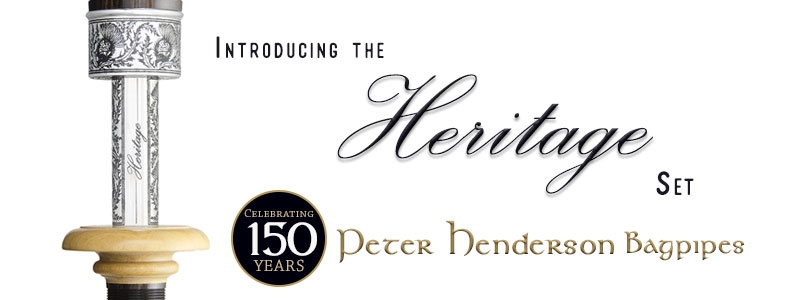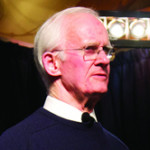 This is from a paper given by author Colin Campbell in the fourth of his series of lectures on pipers and pipe music of the First World War, a National Lottery sponsored project run by the Scottish Pipers’ Association. The piper asked to illustrate the Cameron music was Niall Stewart.
This is from a paper given by author Colin Campbell in the fourth of his series of lectures on pipers and pipe music of the First World War, a National Lottery sponsored project run by the Scottish Pipers’ Association. The piper asked to illustrate the Cameron music was Niall Stewart.
The Cameron Highlanders were founded in 1793 by Alan Cameron of Erracht. The regimental tartan was designed by his mother, a MacDonnell of Keppoch and is a combination of Cameron and MacDonald tartans [see pic below]. Known as the 79th they fought in the French Revolutionary and Napoleonic Wars. At Waterloo they formed a square against the French cavalry, with pipers playing inside the square and Piper Kenneth MacKay playing outside it, purportedly ‘War or Peace, Cogach na sith’. Many will know the story of the two pipers looking at the painting of MacKay. One looked at his fingers and said, ‘There is no F in War and Peace’ and the other replied ‘I don’t know about peace but it looks to me that there was an effing war.’
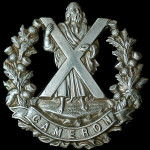 In the 1881 reorganisation the Camerons were the only single battalion regiment the 2nd being formed in 1897 and they subsequently fought in South African War.
In the 1881 reorganisation the Camerons were the only single battalion regiment the 2nd being formed in 1897 and they subsequently fought in South African War.
Some notes on Cameron tunes:
‘We Will Take The Good Old Way’ – Leaving barracks, and better known as ‘The High Road to Gairloch’.
‘The Bugle Horn’ – One of the company marches.
‘The March of The Cameron Men’ – Marching into barracks.
Here are the words to ‘The March of the Cameron Men’
There’s many a man of the Cameron clan,
That has follow’d his chief to the field;
He has sworn to support him, or die by his side,
For a Cameron never can yield.
Chorus
I hear the pibroch sounding, sounding,
Deep o’er the mountain and glen,
While light springing footsteps are trampling the heath,
‘Tis the march of the Cameron men,
‘Tis the march, ’tis the march,
‘Tis the march of the Cameron men.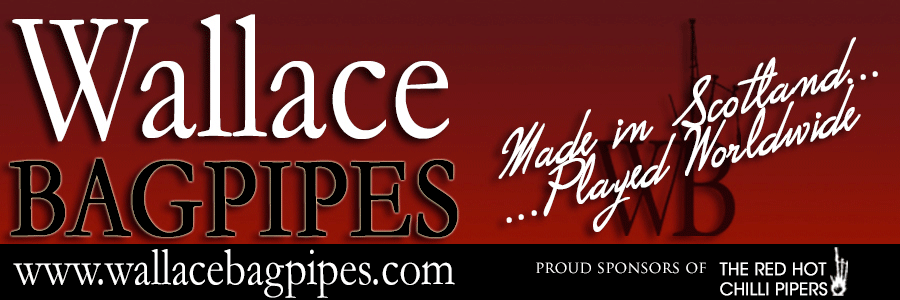
CAMERONS in the GREAT WAR.
The Camerons fought throughout the conflict both in France and at Salonika. A small regiment numerically, yet the 1st, 4th, 5th, 6th and 7th bns (5 out of 7) were at Loos – possibly the most over represented of Scotland’s regiments that day. Very much a Highlands based regiment they had barracks at Inverness, Nairn, Broadford, Fort William, Kingussie, Beauly, Portree – each with roughly four outlying drill stations –e.g. Tarbert, Kilmuir, Lochmaddy and Portree.
Tunes played by Niall Stewart
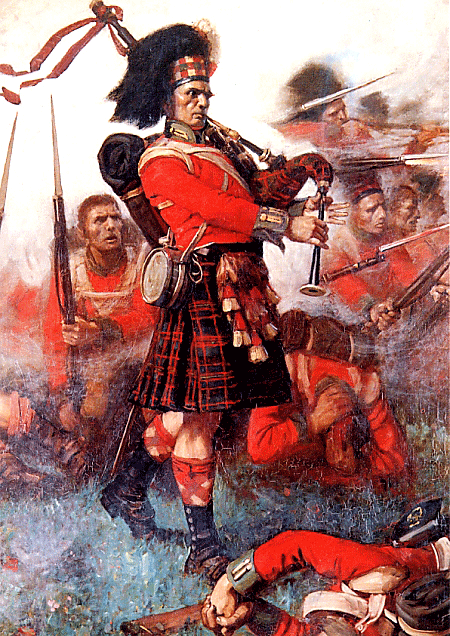 Piobaireachd – part of War or Peace, the Seaforth’s general salute. As already mentioned, this was played by Cameron’s Piper Kenneth MacKay at Quatre Bras (left) who is reputed to have said, ‘It’s all the same to me, in war they’ll kill me, in peace they’ll hang me.’
Piobaireachd – part of War or Peace, the Seaforth’s general salute. As already mentioned, this was played by Cameron’s Piper Kenneth MacKay at Quatre Bras (left) who is reputed to have said, ‘It’s all the same to me, in war they’ll kill me, in peace they’ll hang me.’
On the Somme on 18th June 1915, the Camerons were ordered to the front, and amongst them was a man whose great-grandfather had stood in the square at Waterloo and played Cogadh na Sith.. The padre gave him a set of pipes. The CO told the padre to tell the story of the playing of the tune at Waterloo and 120 men stood at attention whilst the piper played his great grandfather’s tune.’ The tune is in Patrick MacDonald Collection of 1784.
6/8 Marches
Lillie Long Wade’s Welcome to Inverness by P/M Robert Meldrum. Meldrum was born in 1851 and joined the Army at 16. He served in Canada and was P/M of the 93rd from 1887-1892. He retired but re-enlisted at age of 63 in 3rd Camerons Reserve at Invergordon and was released from his duties in 1917.
93rd Farewell to Parkhurst, another by P/M Robert Meldrum. Parkhurst is on the Isle of Wight. Near it were Albany Barracks, completed in 1798 and utilised until the early 1960s when a Category C prison was built on the site. The 93rd were at Parkhurst from 1884 – 1888.
Lt Col H W Kemble of Knock by William MacLean. MacLean was born in 1878 and volunteered 1914. Initially he was P/M of 3/4th Camerons and became P/M of 5th Camerons 1917. He and his pipers led the battalion into Germany playing the ‘March of the Cameron Men’ and ‘All the Blue Bonnets’. Lt Col Kemble was CO of the 3/4th Camerons in Inverness and at Ripon from April 1915 until July 1916 when the battalion was disbanded.
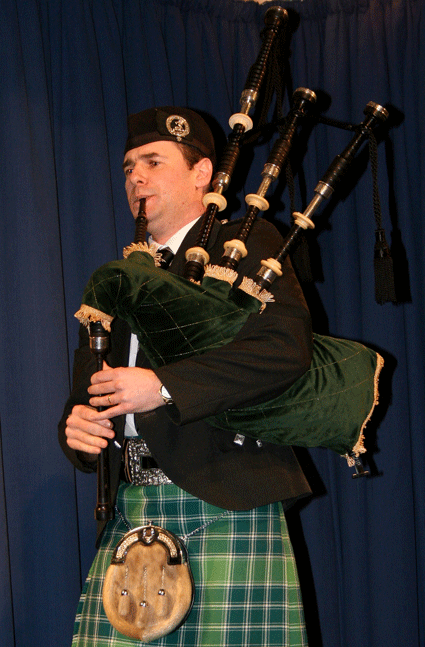
MSR – 2/4 March, the Balkan Hills by J.Gillan. A small British force landed at Salonika in 1915 to aid the Serbs, but were too late to save them. Subsequently several British divisions arrived and created ‘the birdcage’ a massive, well-wired defensive area. They were later joined by French, Russian and Italian troops. The opposition was Austrian and Bulgarian. Several very bloody battles took place until victory was achieved in 1918.
Strathspeys, Because He was a Bonnie Lad – composed by James Paton, b 1851, and retired from Camerons in 1877 as P/M. Recruited for Hounslow Volunteers during WW1, part of the Royal Defence Corps, the WW1 Home Guard. Louisa Campbell by Danny Campbell. Campbell was born in1866 and joined the Cameronians at Lanark aged 15. Made P/M aged only 22, he served in South Africa and later in France with the 5th Camerons (Lochiel’s) and in ’17-’18 was P/M of the 6th Camerons.
Reel, Bessie MacIntyre by William MacLean
Air & jig, The Macedonian Battle Field by J.Steele. Steele served in the 2nd Camerons 1916-1919-was with them in Salonika. Brae Riach by Danny Campbell. Braeriach is the 3rd highest mountain in the UK, on the western edge of the Cairngorms, in Cameron territory.
• To follow: music and pipers of the Seaforth Highlanders during WW1.

